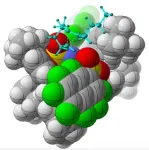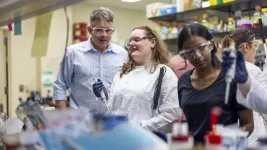(Press-News.org) The holidays may be over, but neuroscientists are getting a special gift to kick off the new year: access to a greatest hits collection from one of Janelia’s longest running and successful Project Teams.
Janelia’s FlyLight Project Team, which has worked for more than a decade to create tools to study the fly brain, is making a core collection of their best genetically engineered fly strains available to researchers worldwide through the Bloomington Drosophila Stock Center. The brain images of these flies, along with hundreds of thousands of images from thousands of additional fly lines, are also now freely accessible through Janelia websites.
These tools – the result of work by hundreds of Janelians and collaborators – will allow fly scientists all over the world to test how individual neurons control behavior. These insights into the fly brain could help scientists better understand how actions are carried out by the brains of larger animals, including humans.
“It’s putting tools into people’s hands, in a way that will help their research and help the community as a whole move forward,” says Geoffrey Meissner, senior manager of Project Pipeline Support at Janelia, who was the project scientist for FlyLight. “Science is a collaborative effort: we stand on the shoulders of giants, and we want to help lift people up as well.”
A team science effort
While research into the fly brain is continuing at Janelia, the release of the fly lines and images marks the conclusion of the FlyLight Project Team, one of the first project teams established at the research campus. These teams bring together dozens of Janelians and visiting scientists for years at a time to take on large-scale efforts that have the potential to transform entire scientific fields but can’t be accomplished in a traditional academic environment or by a single lab. The resulting tools, data, and knowledge are shared widely with the scientific community.
Since FlyLight’s inception in 2008, the team and collaborators have generated thousands of genetically engineered fly strains and brain images, enabling researchers to precisely home in on individual neurons to figure out which cells are controlling specific behaviors. Using these tools, researchers have gained greater insight into how flies see and navigate complex environments, make life-altering decisions like courting their mates, and how memories are represented in the nervous system, among dozens of other findings that could give scientists insight into the functioning of larger brains, including the human brain.
With FlyLight winding down, the team decided to make available a collection of the best of these fly strains, covering a wide range of cell types, so everyone in the scientific community can benefit from these efforts – a core tenet of all the project teams and Janelia’s commitment to open science, says Wyatt Korff, Janelia’s senior director of project teams.
“By partnering with Bloomington, we can ensure that the tools we generated, which we have internally found incredibly valuable, and we know will be incredibly valuable for the whole scientific community, accessible to everyone,” he says. “This collection of the best of the FlyLight Project Team is going to be out there for anyone to use.”
The greatest hits
The 3,000 FlyLight strains at Bloomington enable scientists to use the split-GAL4 method to identify single neurons or cell types in the adult fly brain. These strains cover many parts of the central nervous system and two-thirds of them have not previously been available outside Janelia.
“These 3,000 lines in the omnibus collection are the best of the best – the greatest hits of the split-GAL4 approach,” Korff says.
An additional 1,000 larval fly strains created by Janelia researchers are also being shared for the first time.
By maintaining and providing access to these fly strains, the Bloomington Drosophila Stock Center is helping to preserve the years of work that went into developing the lines and characterizing their neurons.
As the national repository for Drosophila strains, Bloomington is supported by the National Institutes of Health’s Office of the Director, the National Institute of General Medical Sciences and the National Institute of Child Health and Human Development. Because the FlyLight strains are important to understanding brain function, the National Institute of Neurological Disorders and Stroke has been providing special funding for the distribution of previously donated FlyLight strains. Additional support from HHMI enables Bloomington to maintain and distribute the new strains through August 2026.
Since 2017, Bloomington has shipped more than 300,000 samples of these strains to research groups in more than 50 countries. The center anticipates the new strains will also be popular among brain researchers.
“Getting these stocks and making them available to everyone is closing the loop of all the amazing work from Janelia,” says Cale Whitworth, co-director of the Bloomington Drosophila Stock Center.
The accompanying images
In addition to the flies themselves, FlyLight is releasing light microscopy images of their brains and 300,000 images of the brains of other fly strains that the team created over the past decade. Although some of these split-GAL4 combinations are no longer available, stocks for all the split halves were also deposited at Bloomington, so researchers can use these data and Janelia’s NeuronBridge website to search for neurons of interest and create their own fly strains – essentially giving scientists access to the project team’s lab notebook.
These images join previous image releases by the FlyLight Project Team. In total, the team has made 540,000 brain images from 230,000 fly samples available to researchers.
“FlyLight’s mission has been to develop tools to study the fly brain, to develop lines that give us this specific cell-type targeting,” Meissner says. “We are sharing the precise tools to get the job done --to see your neurons and manipulate them in a precise way, to know exactly what you are doing when you make a change in the fly and see what happens. This is making those tools available to the broader fly community.”
END
Janelia shares ‘greatest hits’ of tools to study the fly brain
2024-01-10
ELSE PRESS RELEASES FROM THIS DATE:
Integrating dimensions to get more out of Moore’s Law and advance electronics
2024-01-10
UNIVERSITY PARK, Pa. — Moore's Law, a fundamental scaling principle for electronic devices, forecasts that the number of transistors on a chip will double every two years, ensuring more computing power — but a limit exists.
Today's most advanced chips house nearly 50 billion transistors within a space no larger than your thumbnail. The task of cramming even more transistors into that confined area has become more and more difficult, according to Penn State researchers.
In a study ...
Need for speed: How hummingbirds switch mental gears in flight
2024-01-10
Hummingbirds use two distinct sensory strategies to control their flight, depending on whether they’re hovering or in forward motion, according to new research by University of British Columbia (UBC) zoologists.
“When in forward fight, hummingbirds rely on what we call an ‘internal forward model’—almost an ingrained, intuitive autopilot—to gauge speed,” says Dr. Vikram B. Baliga, lead author of a new study on hummingbird locomotion published in Proceedings of the Royal Society B. ...
Wristband monitors provide detailed account of air pollution exposure
2024-01-10
Environmental epidemiologists at Columbia University Mailman School of Public Health, in collaboration with an interdisciplinary team of researchers at Oregon State University, Pacific Northwest National Labs, and Mt. Sinai School of Medicine, report on the findings of a new study of air pollution exposures collected using personal wristband monitors worn by pregnant individuals in New York City matched with data from a questionnaire. Factors predictive of exposures to air pollution include income, time spent outdoors, maternal age, country of birth, transportation type, and season.
The researchers examined an unprecedented number ...
Scaling up urban agriculture: Research team outlines roadmap
2024-01-10
URBANA, Ill. — Urban agriculture has the potential to decentralize food supplies, provide environmental benefits like wildlife habitat, and mitigate environmental footprints, but researchers have identified knowledge gaps regarding both the benefits and risks of urban agriculture and the social processes of growing more food in urban areas.
In a new paper published in Nature Food, an interdisciplinary group of experts, including a researcher from the University of Illinois Urbana-Champaign, survey ...
Black people face strokes at higher rates, younger ages than white people
2024-01-10
EMBARGOED FOR RELEASE UNTIL 4 P.M. ET, WEDNESDAY, JANUARY 10, 2024
MINNEAPOLIS – Black people consistently had a higher rate of stroke than white people over a recent 22-year period, according to a study published in the January 10, 2024, online issue of Neurology®, the medical journal of the American Academy of Neurology. The study also found that the average age of Black people experiencing stroke was nearly 10 years younger than that of white people, another inequity that grew over time.
“We found that the rate of stroke is decreasing over time in both Black and white people—a very encouraging trend for U.S. prevention efforts,” said study ...
ASBMB announces 2024 class of fellows
2024-01-10
The American Society for Biochemistry and Molecular Biology today announced its 2024 class of fellows. The honorific program recognizes scientists who have made outstanding contributions to the field through their research, teaching, mentoring or other forms of service.
Edward Eisenstein, an associate professor of bioengineering at the University of Maryland and ASBMB Membership Committee chair, and Judith Bond, an adjunct professor of biochemistry and biophysics at the University of North Carolina at Chapel Hill and ...
Researchers step closer to mimicking nature’s mastery of chemistry
2024-01-10
In nature, organic molecules are either left- or right-handed, but synthesizing molecules with a specific “handedness” in a lab is hard to do. Make a drug or enzyme with the wrong “handedness,” and it just won’t work. Now chemists at the University of California, Davis, are getting closer to mimicking nature’s chemical efficiency through computational modeling and physical experimentation.
In a study appearing Jan. 10 in Nature, Professor Dean Tantillo, graduate students William DeSnoo and Croix Laconsay, and colleagues at the Max Planck ...
Dark web fentanyl-selling operations have grown rapidly, offer steep discounts
2024-01-10
Overdose deaths in North America have skyrocketed, primarily because of the spread of illegally manufactured fentanyl. In a new study, researchers analyzed an early and prominent fentanyl-selling operation on the dark web. The organization sustained a significant growth rate, which allowed it to offer consumers steep discounts. In light of these findings, the authors conclude that it might be challenging to constrain supply by shuttering individual organizations since remaining organizations could grow rapidly to fill unmet demand.
The study was conducted by researchers at Carnegie ...
Can drinking alkaline water help prevent kidney stones? Not likely, study finds
2024-01-10
Waltham — January 10, 2024 — Bottled water marketed as "alkaline water" is unlikely to be an effective alternative for prevention of recurrent urinary stones, reports a study in the January issue of The Journal of Urology®, an Official Journal of the American Urological Association (AUA). The journal is published in the Lippincott portfolio by Wolters Kluwer.
"While alkaline water products have a higher pH than regular water, they have a negligible alkali content – ...
Tactile lithophane development makes hard scientific data available to students with blindness
2024-01-10
WACO, Texas (Jan. 10, 2024) – A first-of-its-kind tactile learning device developed by Baylor University chemistry professors to make science accessible to students with blindness or low vision (BLV) has opened the possibility of the transfer of any scientific data or images for sighted students into functional, thorough formats for students with blindness. The study was published today in the journal Science Advances.
The latest research from Bryan F. Shaw, Ph.D., professor of chemistry and biochemistry at Baylor, focused on the development of a codex using lithophane – an ancient art form – to convert images from scientific textbooks into tactile ...







